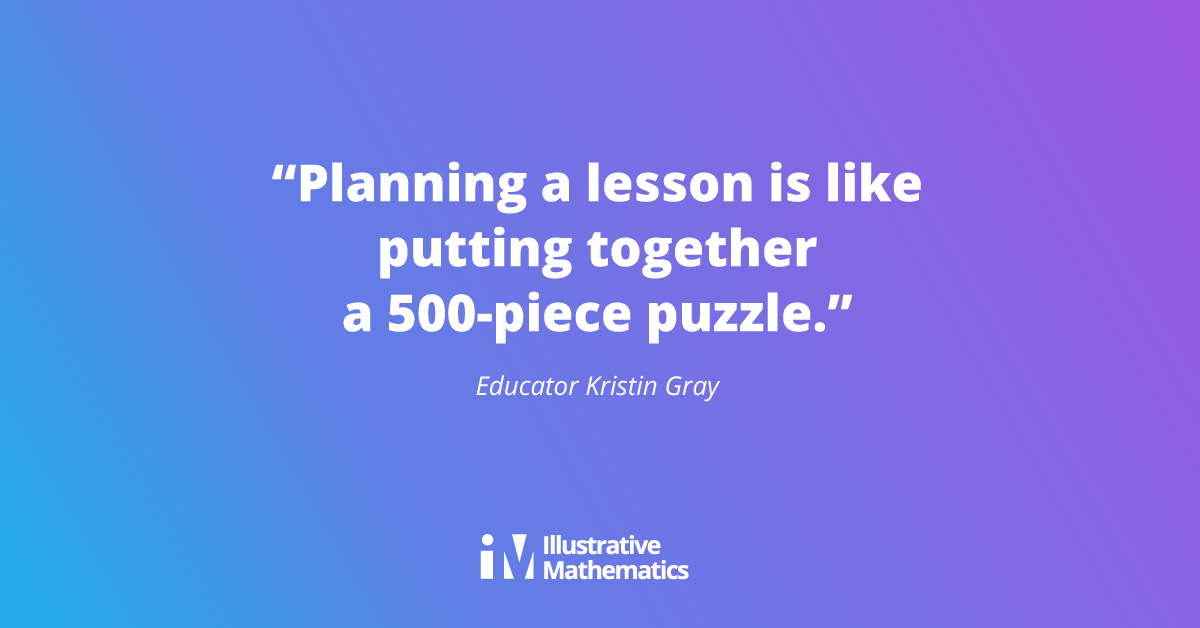“Whether we’re asking students to analyze a historical event, reflect on a text, or work toward a scientific discovery, we need to give students a chance to dig into the ideas on their own first.”
By Kristin Gray
I’ve come to think that approaching a lesson plan is like approaching a 500-piece puzzle. It’s hard to know where to start. It takes time. It involves endless trial and error. But when it’s finished – when all the pieces have been put in place – there’s a sense of pride and accomplishment.
I’m a math teacher, and when I shared this reasoning with other teachers for the first time, I included a lot of beautiful words around mathematical connections, but in the middle somewhere, I used the phrase “making connections explicit.” The room seemed to recoil. I paused to reflect on why teachers were withdrawing. I asked them, “Was it the word ‘explicit?’” There were nods throughout the room.
Trust me, I get it. The word “explicit” has developed a cringe-worthy connotation among peers in the math community. In the past, if I were asked to paint a picture of a math teacher engaging in “explicit” teaching, I would have painted either a teacher standing up at the front of the room, telling students how to solve a problem, or a teacher crouched down next to a struggling student, “correcting” the way the student approached the problem because they were taking the “long way there.”
These scenarios make us cringe, because we know they don’t lead students to true understanding. I think there are parallels in teaching other subject areas as well. Whether we’re asking students to analyze a historical event, reflect on a text, or work toward a scientific discovery, we need to give students a chance to dig into the ideas on their own first.
In a math classroom, an “explicit” teacher tells students how to approach math, typically by way of a procedure. There’s no discovery. But, when we purposefully plan using a problem-based curriculum in our classroom – setting up investigations for our students, designing and implementing routines and fostering intentional talk – we can change what it means to be “explicit.”
When we plan and teach lessons – in any subject area – we make hundreds of decisions around a specific learning goal. We make decisions about the questions we’ll ask to help students see connections. We make decisions about which particular pieces of student work to share at the end. In each of these choices, we are being explicit about the idea we want to bring to light.
We are explicitly planning, not explicitly teaching.
I’ve had many moments of frustration when planning and teaching a problem-based curriculum. Ideas can go unnoticed. Connections can go unmade. I sometimes used to spend the end of class standing at the board, frantically trying to explain something, because I was worried students were about to leave without getting “the point” of the lesson. Somehow, the kids didn’t read my mind! Moments like this came about because my planning wasn’t explicit enough.
I’ve found Mary Kay Stein and Peg Smith’s “5 Practices Framework” a useful tool for explicit planning. The framework forces me to think continuously about the goal, choose an activity that supports that goal, plan questions to move students toward the goal and sequence student work in a way that creates a productive, purposeful discussion toward an explicit idea. I believe this could work in any subject area, as a way of supporting our students in their development of true understanding.
Mary Kay Stein and Peg Smith’s “5 Practices Framework:”
- Anticipate what students will do – what strategies they will use – in solving a challenge.
- Monitor student work as they approach the challenge in class.
- Select students whose strategies are worth discussing in class.
- Sequence those students’ presentations to maximize their potential to increase students’ learning.
- Connect the strategies and ideas in a way that helps students understand the concepts learned.
Mary Kay and Peg also describe a Practice 0 of Choosing a Mathematical Goal and Appropriate Task in their book – like selecting the right puzzle to put together on a particular day.
This framework can apply across various contexts and subject areas, but I think it’s embodied in the open education resource (OER) curriculum by Illustrative Mathematics. Each lesson and unit tells a mathematical story in which students arrive at a specific mathematical landing point. While students may not all arrive in the same way or at the same time, the problems and discussions are structured to ensure students don’t leave the day’s work without understanding the goal.
Explicit planning requires us to understand the final picture – the goal – before the puzzles pieces can come together. It requires us to carefully connect each piece, because one missing piece will leave the final picture unfinished. While planning lessons for our unique groups of students, we may not at first see exactly how each puzzle piece will connect, and sometimes we can feel stuck. But our colleagues and students can help until all the connections are clear – and we’re proud of the final picture we see.
Next Steps
- Check out the video to see teachers learning about these 5 Practices in a recent IM professional development.*
- Find a sample lesson plan written using the 5 Practices here: Grade 6, Unit 3, Lesson 4, Activity 1: Road Trip in Illustrative Mathematics 6–8 Math Curriculum.
- If you are reading the 5 Practices book, I would love to hear your personal connections and reflections as you read.
- If you are using the 5 Practices to plan for activities in your classroom, I would love to hear about your experiences.
- Click here to learn more about professional development of the 5 Practices for your classroom or school.
